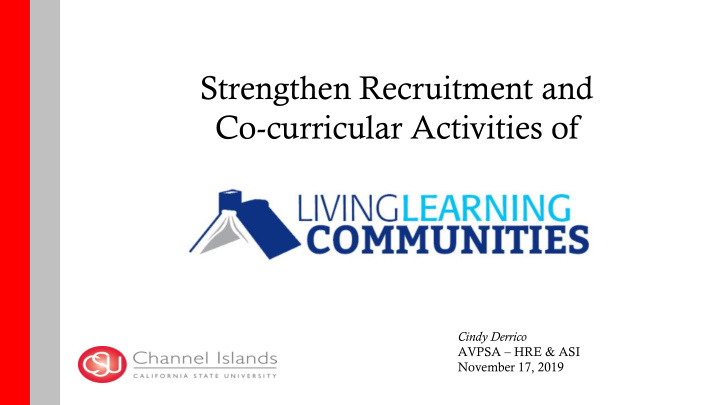



Strengthen Recruitment and Co-curricular Activities of Cindy Derrico AVPSA – HRE & ASI November 17, 2019
Why Living-Learning Communities? “Living -learning programs appear to embody everything higher education pundits advocate: They intentionally create small and intimate communities of membership; at their most optimal, they unite curricular, co-curricular, residential, and informal peer networks to augment student learning and development” (Inkelas, 2008, p. 9).
Benefits of LLCs • Positive peer and faculty interactions with faculty and peers • Greater use of residential resources to support learning and adjustment • More inclined to perceive residence hall as socially and academically supportive • Higher critical thinking scores and knowledge-application abilities • Greater confidence in test-taking skills and college success • Higher confidence in writing courses, English, and math • Better class attendance, lower likelihood to be feel overwhelmed by their studies • Greater interest in sustained intellectual challenges in liberal arts and learning • Greater civic engagement, diversity appreciation, and opening to different views • Greater sense of belonging at institution and smoother transition to college life The National Study of Living-Learning Programs Inkelas, Drechsler, et al., 2007
CSUCIs LLCs • Michelle Serros Multicultural LLC • New in 2018 • Capacity for up to 40 frosh co- enrolled in three courses.
CSUCIs LLCs • Bedford and Dr. Irene Pinkard Multicultural LLC • Started in 2019 • Capacity for up to 20 frosh co-enrolled in four courses.
CSUCIs LLCs • Windows on the World (WOW) International LLC • Started in 2018 • Capacity: Up to 40 frosh co-enrolled in three courses.
CSUCIs LLCs • Student Undergraduate Research Fellows (SURF) Integrative LLC • Started in 2015 • Capacity: Up to 20 frosh co-enrolled in four courses.
CSUCIs LLCs • Outdoor Adventure Community Engagement LLC • Started in 2015, adapted to LLC (from Theme Community) in 2018 • Capacity: Up to 40 frosh co- enrolled in three courses.
Fall 2019 Participation Capacity # of Courses Residents Serros 40 3 21 Pinkard 20 4 12 WOW 40 3 21 SURF 20 4 14 Outdoor 40 3 25 160 93
Alignment with CSUCI Strategic Initiatives • Educational Excellence – Collaborating across Academic and Student Affairs to increase student engagement – Ensuring faculty and programs are supported to promote educational excellence – Additional Strategic Initiative Strategies: 1.4, 1.6, 1.7
Alignment with SIs • Student Success – Promoting timely degree progression – Developing innovative partnerships between Academic and Student Affairs – Additional Strategic Initiatives Strategies: 2.1, 2.5, 2.6 • Inclusive Excellence – Improving graduation rates for students from historically underserved populations – Additional Strategic Initiatives Strategies: 3.6
Alignment with SIs • Capacity and Sustainability – Building self-sustaining programs and initiatives that support and equitable and thriving community.
CI Longitudinal Data Analysis – 2011 - 2008 Leslie Abel’s quantitative analysis (investment of SI funding from last year) After controlling for multiple individual/pre-college factors, Regression Analysis predicted: • Higher CI and overall GPAs at the end of first term and first year • Total units attempted in the first year • Decrease in number of DFWIs in the first term • Lower likelihood of bad academic standing after first term and first year – Data showed retention is higher, particularly in RISE, but result not significant
CI Longitudinal Data Analysis – 2011 - 2008 Propensity Score analysis – matched pairs on HUGS, 1 st Gen, Pell-eligible, and Gender • Higher GPAs (both CI and total GPAs end of the first term & 1 st year) • More total units attempted in the first year • A higher probability of being retained to 2 nd term and 2 nd year • Fewer DWFIs in the first term • A lower probability of being in bad academic standing at the end of the first term and end of the first year Note: Over-representation of HUGS in LCs, increasing the importance of this intervention.
LLC SI Purpose of Funding Request 1. Establish consistent and persistent support of LLC processes and participants • Develop regular communication throughout the admission and yield pipeline to increase clarity and participation for students. • The program has champions but not dedicated support to assure recruitment and retention in the LLCs • Support data collection and overall improvement of LLC processes and programs. 2. Address engagement and satisfaction assessment from participants • Increase structured programming in support of LLC/Theme • Organize study groups • Deepen community development
LLC SI Outcome Goals 1. Increase student retention – from current 84% to 91% 2. Increase student participation to maximize capacity from 62 students spring 2019 to 105 students in fall 2020 3. Incorporate LLC data into DSA Dashboard 4. Educational activity consistency 5. Academic Advising each semester 6. One regular study group per LLC 7. Increase student satisfaction above 80%
Proposed Budget HRE Item: Amount SI Funding Support LLC Coordinator 54,000 54,000 Benefits 30,780 30,780 Recruitment Travel @ $500 for 4 trips 2,000 2,000 Two Student Assistants @ $13/hour @ 20 hours/week 19,760 19,760 Co-curricular Program Funding @ $500/event 2,500 2,500 ACUHO-I Academic Initiatives Conference 2,500 2,500 Totals: 111,540 84,780 26,760
References • Abel, L. (2019). A quantitative assessment of CSU Channel Islands’ learning communities. Unpublished manuscript/data analysis, California State University Channel Islands, Camarillo, CA. • Inkelas, K. K. (2008). Living-learning program research and practice. The Journal of College and University Student Housing, 35 (1), 8-13. • Inkelas, Karen Kurotsuchi, Marybeth Drechsler, Katalin Szelényi, Yoolee Choe Kim, Graziella Pagliarulo McCarron, Matthew Soldner, Aaron M. Brower, Scott Crawford, Brian Hempton, and Tina Mainieri.(2007). National study of living- learning programs. UW-Madison Customized Report .
Recommend
More recommend